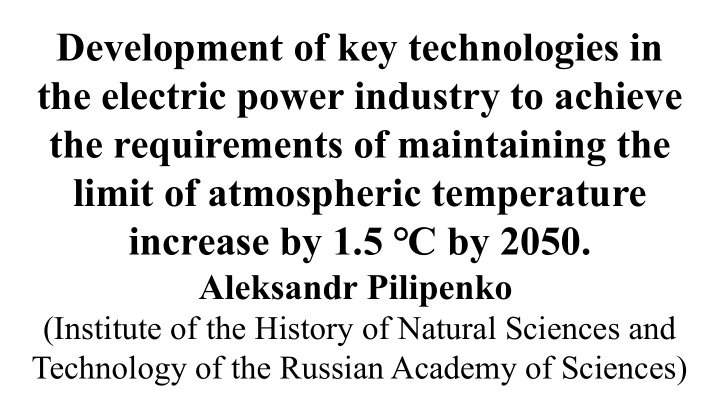



Development of key technologies in the electric power industry to achieve the requirements of maintaining the limit of atmospheric temperature increase by 1.5 ℃ by 2050. Aleksandr Pilipenko (Institute of the History of Natural Sciences and Technology of the Russian Academy of Sciences)
2 To completely eliminate CO2 emissions by 2050, the pace of realization of the potential of renewable energy is not enough. The most probable ratio of carbons and renewable energy by 2050 is ½ by ½
The first 20 MW chilled ammonia system (Alstom) at AEP's Mountaineer coal power plant in New Haven, WV, USA, 2011
4 Alstom CO2 capture plant in West Virginia coal- fired power plant (close-up, see N 3)
5 Alstom and Dow Chemical Co. Pilot Plant 2 MW. Captures CO2 from the flue gases of a coal boiler at the Dow facility in Charleston, West Virginia. Alstom and Dow patented amine technology for 1800 tons of CO2 per year. 2009
6 BASF ─ Linde CO2 flue gas capture at a coal plant in Wilsonville, AL, USA. 2016. 30 t/d CO2
Pilot project RWE ─ BASF ─ Linde (Niederaussem, Germany). Lignite. 7.2 t/d CO2. 2017
Boundary Dam is the first industrial CCS on coal, CO2 90% and SO2. SaskPower, Canada 110 MW, 1 million tons of CO2 per year. 2014 (appearance)
9 Boundary Dam, 2014, CO2 and SO2, 110 MW, 1 million tons of CO2 per year (close-up, see N 8). Technology Cansolv Technologies Inc. (CTI), Canada
10 Brown Mining 10 Miles from Boundary Dam
1 The second industrial unit, Petra Nova, coal-fired, 240 MW, 1.6 million tons of CO2 per year. Texas, 2017, Mitsubishi Heavy Industries Engineering technology with Kansai Electric Power Co., KM-CDR Process ™
12 14.9 MW CCS ExxonMobil installation on natural gas with FuelCell Energy in Bridgeport, CT, USA. 2017
13 The cost of CO2 capture in CCS technology for coal-fired power generation is about twice the cost of CO2 capture in natural gas power generation (ExxonMobil)
14 Allam cycle scheme with 100% CO2 capture. CO2 as a working fluid instead of water vapor normally
15 Power plant NET Power 50 MW with microturbine according Allam cycle, 2018, La Porte, TX, USA
16 Power plant NET Power 50 MW, 2018, Texas, 100% CO2 capture (landscape view, see N 15)
17 A core sample showing how CO2 in basalt in two years turned into an ancherite mineral. Pacific Northwest National Laboratory experiment − PNNL. USA. 2016
18 Carbon capture and storage (CCS) facilities are considered as key contributors to emissions reduction, with 18 of the world’s large-scale CCS plants currently capturing approximately 40 million tons per annum of carbon dioxide (CO2), according to The Global CCS Institute.
19 Hybrid system configuration, 250 kW, combining SOFC with micro gas turbine (MGT) from Mitsubishi Hitachi Power Systems, Ltd. (MHPS), 2018
20 Hybrid System Appearance, 250 kW, SOFC-MGT by Mitsubishi Hitachi Power Systems, Ltd. (MHPS), 2018
21 High-performance (500 Wh/liter) lithium battery with fast charging and high safety of the Czech company HT3DA. Efficiency above 95%. Lifespan 5000 cycles
22 Conclusion The widespread introduction of the technologies considered makes it possible in principle to limit the increase in atmospheric temperature to 1.5 ℃ by 2050. The feature of the present time is the completion of the long stages of research and development that led to the emergence of commercial projects for the key technologies considered. Their expansion is necessary in order to obtain additional volumes of electricity relative to renewable energy without CO2 emission to satisfy all the needs in the world by 2050.
Recommend
More recommend